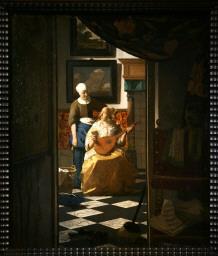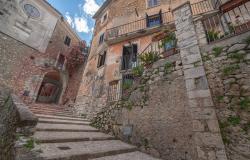The Italian capital has opened its doors on one of the most eagerly awaited shows of the year, celebrating the golden age of Dutch art.
The exhibition in Museo del Corso features 55 masterpieces by some of the greatest names of the 17th century, including Jan Vermeer and Rembrandt.
All the showcased works are on loan from Berlin's Gemaldegalerie, which selected pieces designed to explain the artistic revolution that swept the Netherlands at the time.
''A variety of changes combined to create the conditions needed for the birth and success of a variety of new artistic genres,'' explained Bernd Lindemann, the Gemaldegalerie's director and curator of the Rome event.
The exhibit's poster image is Woman With A Pearl Necklace, an intimate, domestic work showcasing Jan Vermeer's skill at depicting luminosity.
Rembrandt's paintings include The Money Changer and a portrait of Hendrickje Stoffels, the painter's young maid, who became his lover for many years.
Also on show is Man In A Gold Helmet, considered one of Rembrandt's greatest works for many years but now attributed to one of his unknown students.
Another painting whose perception among critics has changed of late is a 1654 work by Gerard ter Borch. Officially untitled, it used to be called The Paternal Admonition, as it was thought to show a young woman being reprimanded by her father, as her mother looked on.
However, the painting has recently been renamed The Gallant Conversation, after extensive research revealed it was probably intended to depict a prostitute, her madam and a potential client.
A more innocent painting is Frans Hals' Singing Boy with a Flute, showing a smiling youth, instrument in hand.
Pieter de Hooch, famous like Vermeer for his indoor scenes, has two of his popular paintings on show: The Mother and Woman Weighing Gold.
Dutch artists moved to the centre of the European cultural stage during the 17th century, drawing international attention and influencing their peers across the continent.
The exhibition not only examines the differences between Dutch and Italian art, it also looks at the similarities, particularly the influence of Italian artists and how Dutch painters developed their treatment of light.
In addition, the show focuses on how the changing domestic climate led to a shift away from the previous pattern of aristocratic patrons, forcing artists to compete for the attention of individual buyers among the bourgeoisie.
This resulted in more popular and accessible works, as formal portraits segued into more intimate depictions of people in their personal, domestic settings.
Entitled Da Rembrandt a Vermeer. Valori civili della pittura fiamminga e olandese del '600 (Rembrandt To Vermeer. Civil Values in 17th-century Flemish and Dutch Painting), the exhibition runs until February 15.










